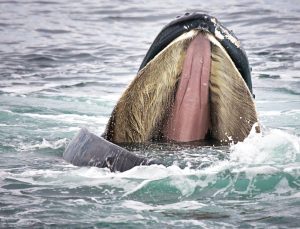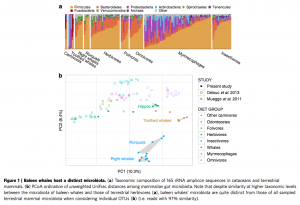Baleen whales host a unique gut microbiome with similarities to both carnivores and herbivores
By Julia Whidden, RJD Graduate Student
“Microbiome” is the term used to describe the communities of microorganisms that live inside a host, and includes microorganisms that are beneficial, detrimental, and neutral to host health. Some of these microorganisms are vital to digestion, but the diversity, composition, function, and source of an animal’s microbiome is still largely understood. For example, the microbiome of the herbivorous panda bear was expected to host communities similar to other herbivores with the same diet, while in actuality its communities were discovered to be more similar to other closely related yet omnivorous pandas. Cetaceans, or dolphins and whales, evolved from artiodactyls, which were terrestrial animals that fed on plants. Other modern-day animals evolved from artiodactyls include cows and hippopotamuses, or ruminants, and are similar to this ancestor in their herbivorous diet. The main polysaccharide, or large carbohydrate that herbivores acquire from their diet is cellulose. Whales, however, are carnivorous. Even baleen whales that are filter feeders consume small fish and crustaceans, digesting another large carbohydrate, chitin, from the ‘shells’ of their prey. Despite vastly different diets, ruminants and whales share a multichambered foregut, which is used in these animals to help digest the tough structure of the large polysaccharides they consume. This study investigated the microbiome of baleen whales to determine whether their community composition was more similar to their ancestor and distant relatives, the herbivores, or to their carnivorous diet.
Fecal samples were collected from wild baleen whales in the Bay of Fundy, Canada, in August 2011, and were complemented by samples of captive cetaceans and wild terrestrial animals. The wild fecal samples were obtained by first locating and identifying the whales, and then samples were scooped from the water immediately following defecation. Captive cetacean and wild terrestrial animal samples included Pacific Humpback whales, Atlantic white-sided dolphins, bottlenose dolphins, Beluga whales, hippopotamus, and other unnamed wild terrestrial carnivores and herbivores. DNA extraction from the fecal samples isolated 16S ribosomal RNA (rRNA), which is involved in protein synthesis in ribosomes. An analysis of 16S community sequence was performed, which indicates the diversity in a microbiome by identifying the number of gene variants present, assuming each microorganism has a different variant of the gene. The microbiome diversity within each group of animals – including the baleen whales, toothed whales, terrestrial herbivores, and terrestrial carnivores to name a few – was then compared (see Figure 1 below).
Results indicated that the microorganisms of the baleen whale’s microbiome involved in the digestion of polysaccharides were similar to those of terrestrial herbivores. This is intuitive, as the chitin that the baleen whales consume is similar in structure and function to the cellulose that herbivores consume. Further, the baleen whale microorganisms responsible for breaking down proteins and building amino acids – which make up proteins – were more similar to the microbiome of the terrestrial carnivores analyzed. This study concluded that microbiome composition is determined by a mix of the host’s past and present, incorporating microorganisms associated with their ancestor’s diet, as well as their modern diet.


